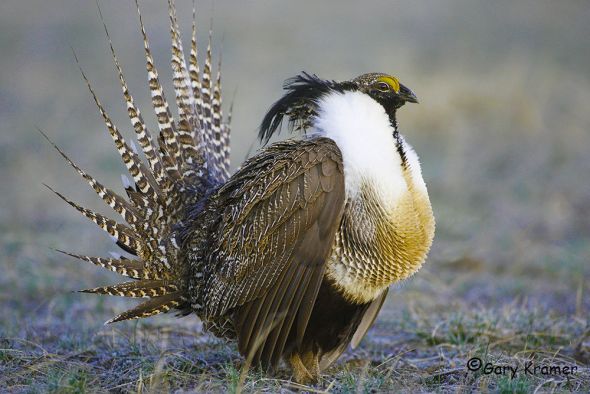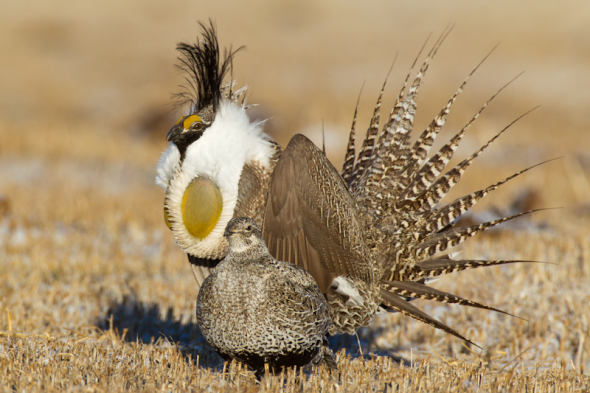Endangerd Species Monday - Centrocercus minimus

Endangered Species Monday - Centrocercus minimus
Picture credits: Gary Kramer Photography.
This Mondays endangered species article I take a glimpse into one of the planets most endangered bird species and one of the millenniums kind of newest discoveries, or more “an overlooked species should I say”.. The Centrocercus minimus, commonly known as the Gunnison Sage Grouse is the bird I am speaking about and, not the “Greater Sage Grouse”. C. minimus species is listed as (endangered) of which its populations are declining quite extensively. The species was identified back as a “new species” by Dr Mark Young et al 2000 after environmentalists believed the species to be the near threatened Greater Sage Grouse. Thankfully after much research this stunning bird and its non-similarities to the Greater Sage were finally uncovered.
Endemic only the United States population sizes are very, very sparse and limited. From census counts back in 2005 mature individuals stand at a depressing 1,700. This roughly equates to around 2,500-2,600 total individuals if that. If there is one bird within the United States that could benefit from “extreme conservation preservation” C. minimus is one out of several unrelated species requiring immediate protection status.
Conservation actions began back in 2005 of which a working group was formed to protect and oversea all conservation projects of this magnificent bird. Back in 2008 a conservation plan identified over 200 actions that required immediate addressing to stop its sudden decline into extinction. By 2005 over ninety five percent of the population was covered by working groups.
Conservation actions proposed/underway:
Restore and improve habitat, while continuing work to prevent further loss and fragmentation. Support its listing on the Endangered Species Act. Continue population monitoring at key sites. Conduct further ecological research, focusing on survival, dispersal and habitat use at different life stages. Encourage and facilitate the implementation of local and range-wide management plans. Reduce disturbance, especially at active leks. Investigate the possibility of using translocations to augment small populations. Continue work to raise awareness of key issues among stakeholders.
Image: Gunnison Male. Males fan their feathers, strut while popping air sacs in their chests. Males put this show on to attract females. Behavior becomes aggressive when females are present.
Gunnison Sage Grouse are notable for their elaborate courtship rituals. Each spring males congregate on leks and perform a “strutting display”. Groups of females observe these displays and select the most attractive males to mate with. Only a few males do most of the breeding. Males perform on leks for several hours in the early morning and evening during the spring months. Leks are generally open areas adjacent to dense sagebrush stands, and the same lek may be used by grouse for decades.
Threats
Habitat loss, degradation and fragmentation is resulting from conversion to roads, reservoirs, livestock-grazing, hay and other crops, real estate developments, power lines, land treatments and increased deer populations - hence why hunters do participate in seasonal hunting of deer to keep populations in check and from destroying Gunnison Sage Grouse’s habitat.
Many winter sites are directly threatened and being enclosed by urbanization. Severely fragmented populations have low genetic variation and the recent reintroduction of the disease West Nile virus to the species’s range is a concern. Inbreeding depression appears to be occurring due to the skewed mating system at leks: six of the seven extant populations now appear to be low enough to be suffering from this. Disturbance from scientific study and recreational birdwatchers may cause stress and reduced lek attendance and production.

Male Gunnison Sage-Grouse displays on the lek during a spring mating season at Mill Creek Ranch in Gunnison, CO.
Severe winters and potentially droughts may represent survival bottlenecks (e.g. in 1984, less than 10% of sagebrush emerged above the snow as may other habitat factors influencing chick survival. Calls to increase gas prospecting in areas of sagebrush habitat represent a potential future threat.
Hunting has since been banned when the new species was formally identified back in 2000 and conservation actions began. G. Sage Grouse is mostly confined to Colorado with some smaller populations confined to Utah. The species has been recognized by the American Ornithological Union as one of the ten most endangered species of birds in North America. It is therefore listed as a possible candidate for future protection under the Endangered Species Act (ESA). However, while numerous groups have developed conservation plans and actions for the species; it continues to be at significant risk and lacks federal protection under the ESA.
Thank you for reading.
Dr Jose C. Depre.
Chief Environmental and Botanical Officer (CEO)




